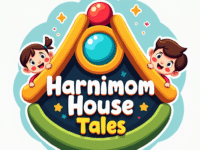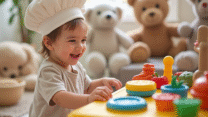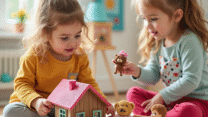
Empathy for Toddlers: Storybooks That Build Caring
.
Heartwarming Storybooks to Build Empathy
Empathy is one of the most powerful life skills we can begin to nurture in toddlers. It’s the ability to notice how others feel, respond with care, and build deep, healthy relationships. While empathy may sound like a big concept for little ones, it actually begins in small, everyday moments—and storybooks are one of the most effective tools to bring those moments to life.
Why Empathy Matters in the Toddler Years
Between the ages of 1 and 3, children are laying the emotional foundation for empathy. Even before they can fully express their own feelings in words, toddlers are:
- Watching how adults and peers respond to emotions
(Is Mommy gentle when someone cries? Does Daddy offer help or comfort?) - Learning to label emotions
(“I feel sad.” “He’s mad because his toy broke.”) - Starting to comfort others
(Hugging a friend, offering a blanket, saying “It’s okay.”)
These are powerful milestones—and storybooks help make them visible, understandable, and repeatable in a toddler’s world.
How Storybooks Grow Empathy
Toddlers may not yet have the vocabulary or emotional maturity to talk about empathy—but they feel it. And storybooks are a gentle, safe way to explore emotions and social situations they’re just beginning to understand.
Here’s how stories help:
1. Characters Feel First—So Toddlers Can Too
Books allow toddlers to experience emotions from the outside in. By watching a character feel sad, scared, or excited, children begin to mirror and recognize those emotions in others and themselves.
“Look, the bunny feels lonely. What do you think would help him feel better?”
2. Stories Show Cause and Effect of Actions
Kindness and unkindness have consequences. Through storytelling, toddlers see how choices—like sharing or hurting—impact others. And they begin to form their own inner compass.
“That friend didn’t get a turn. How do you think she feels?”
3. They Normalize Empathy as Part of Play
Stories often model simple, age-appropriate empathetic actions:
- Offering a toy
- Saying sorry
- Listening when someone is upset
Reading these actions over and over helps toddlers rehearse empathy in their own lives.
4. Books Build Emotional Language
The more words toddlers have to describe emotions, the better they can identify, talk about, and regulate those feelings. Books introduce vocabulary like:
- Happy
- Sad
- Frustrated
- Worried
- Proud
- Brave
Each word is a tool for connection.
What to Look For in Empathy-Building Storybooks
Not all books are created equal when it comes to emotional learning. When choosing storybooks that support empathy development, look for ones that:
- Use realistic emotional experiences (losing a toy, saying goodbye, making a new friend)
- Show diverse characters and relationships
- Include gentle conflict resolution
- Focus on kind, inclusive behavior
- Avoid heavy moralizing—choose books that show, not preach
Reading Tip: Make It Interactive
As you read, pause and ask:
- “How do you think they feel?”
- “What would you do if that happened to you?”
- “Have you ever felt that way?”
These small moments deepen understanding and help toddlers apply empathy to their own experiences.
Final Thoughts: Empathy Starts Small
Empathy isn’t taught in one big lesson—it grows over time, through gentle modeling and meaningful stories. When you read picture books that show kind actions, emotional awareness, and human connection, you’re not just entertaining your toddler.
You’re helping shape a person who notices others, cares deeply, and knows how to respond with compassion.
That’s the quiet power of storytime—and the beginning of a kind heart.
Lila and the new Paint Brush-Lila feels jealous by Juliet James
Lila loves painting, especially when she gets to share ideas and colors with her best friend. But one day, her friend brings a brand-new paintbrush —and suddenly, Lila starts to feel something unfamiliar and uncomfortable: jealousy.
As her joy fades, Lila begins to pull away from the one person she’s always felt close to. With an honest talk with her friend, Lila learns that jealousy is a normal feeling—and that true friendship means supporting each other, even when it’s hard.
A thoughtful, relatable story that helps children understand big emotions, strengthen friendships, and celebrate their own unique creativity.

SHOP NOW
The Rabbit Listened by Cori Doerrfeld
A quiet, powerful book about the best response to big feelings: just being there. Ideal for showing toddlers that they don’t always need to fix things—sometimes, listening is enough.
Have You Filled a Bucket Today? by Carol McCloud
This book introduces the concept of “bucket filling” as a metaphor for kindness. It’s engaging, easy to understand, and encourages everyday empathy.
I Am Human: A Book of Empathy by Susan Verde
A beautifully illustrated book that affirms our shared humanity and gently guides children toward compassion and understanding.
Empathy in Daily Toddler Life: Easy Activities
Help your child practice empathy with these book-inspired ideas:
- Feeling Check-Ins: Ask, “How do you think the bunny felt?” during storytime
- Pretend Play: Use dolls to act out emotions and comforting gestures
- Kindness Catchers: Spot acts of empathy and name them: “You gave your toy to help—so kind!”
- Emotion Sorting Game: Use printable cards or photos to match facial expressions to feelings
- Comfort Kits: Make a mini “help kit” with a tissue, sticker, or toy to give a friend in need
Free Printable: Toddler Feeling Faces Pack
Help toddlers recognize and name emotions with this visual pack:
- Faces showing common toddler emotions (happy, sad, mad, nervous, excited)
- Matching emotion cards with simple language
- Prompt cards like “What would help this friend feel better?”
Download the Toddler Feeling Faces Pack →
Final Thoughts
Empathy doesn’t come from a single moment—it’s grown in the everyday. By reading stories together, noticing feelings, and naming kind acts, you’re laying the foundation for a compassionate, connected child.














Leave a Reply